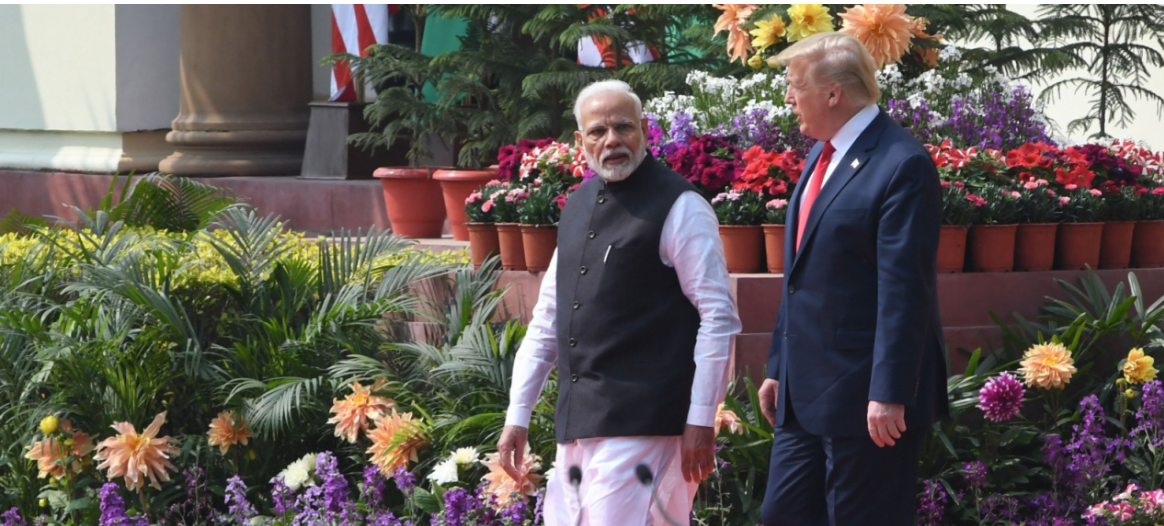Why the US and India Need a New Vocabulary of Partnership

Washington and New Delhi will only get along when both accept permanent ambiguity as a feature, not a bug, of the partnership.
It has become a familiar refrain in recent strategic commentary that India risks squandering its moment by refusing to commit to the West. In this framing, articulated persuasively in a recent essay for Foreign Affairs by Dr. Ashley Tellis, India is either deluding itself about the realities of Chinese power or simply freeriding on American restraint. In both cases, the implied solution is the same: align more decisively with the United States. But this interpretation, while not wholly wrong, is profoundly incomplete. It misunderstands India, and more worryingly, it also misunderstands the United States.

The essay has drawn thoughtful support as well as incisive criticism. Lisa Curtis, echoing Dr. Tellis, warns that India’s strategic ambiguity risks undermining shared goals. She argues for a stronger, more institutionalized Quad—the grouping of the United States, India, Japan, and Australia—as the clearest path to regional stability. Others dissent. Retired Indian diplomat Nirupama Rao contends that India’s ambiguity is not drift, but a strategic doctrine grounded in its history and a challenging geography. Dhruva Jaishankar similarly argues that India’s layered approach reflects deliberate flexibility rather than policy incoherence.
These rebuttals effectively counter Dr. Tellis’s critique, but they don’t escape its underlying assumption: that the measure of this relationship is how closely India aligns with American geopolitical priorities. Even in defending India’s autonomy, the debate still circles around Washington’s question rather than interrogating whether it’s the right one in the first place. While the debate focuses aptly on correcting American misperceptions of India, the problem is deeper.
The real issue in US-India relations is not whether India will align, but that both sides persist in judging the partnership through an alliance vocabulary that no longer fits. These conceptual differences may be rooted in distinct histories and strategic philosophies. We need a new language, rooted in today’s realities, for describing what this partnership really is.
American Expectations, Indian Reservations
For over two decades, US foreign policy elites have bet on India as the democratic counterweight to China, assuming that shared democratic values would translate into common geopolitical interests. India, however, has rarely behaved like a traditional ally. It abstained from UN votes on Ukraine, refused to join Western sanctions on Russia, and maintains close defense ties with Moscow. In Washington, this understandably triggers frustration: why won’t India pick a side? And why does it hedge when the stakes seem so obvious?
At first glance, it may seem that the expectations are mismatched. The United States, accustomed to engaging with treaty allies such as NATO members, Japan, and Australia, often assumes a similar logic will apply to India, in which partners align politically, coordinate their policies, and treat US priorities as broadly their own. But India insists on strategic autonomy. Its foreign policy, shaped by deep-rooted postcolonial instincts and an enduring legacy of non-alignment, resists being cast into predefined roles. When US officials describe India as a “linchpin” or a “net security provider,” the intent may be respectful. Still, to Indian ears, it can sound like a nudge to be more aligned and more predictable.
The deeper issue, however, isn’t just mismatched expectations, but fundamentally different concepts of what partnership requires. Where America sees policy coordination as natural alignment, India sees it as a constraint. Where India sees flexibility as sovereignty, America sees it as unreliability. These reflect incompatible frameworks for understanding partnership, rooted in distinct historical experiences and strategic philosophies.
For instance, while the United States treats democracy as a foreign policy brand and a rallying point for coalitions and partnerships, India sees its democracy as a domestic inheritance, not necessarily an instrument of foreign policy. When US officials invoke democracy as grounds for alignment, it can sound in New Delhi less like solidarity and more like an attempt to incorporate India into a Western-led ideological project.
The practical consequences of these different concepts are evident across multiple issues. Consider India’s energy diplomacy. While Washington urges decoupling from Russia, India has expanded purchases of Russian crude, citing both price and pragmatism. When challenged, Indian officials point to the European Union’s purchase of Russian gas and ask, “Why is Indian energy security treated differently?” Similarly, India’s outreach to Iran through the Chabahar port development is viewed in Washington primarily in terms of sanctions. At the same time, New Delhi sees it as gaining access to Central Asia and serving as a counterweight to China’s Belt and Road Initiative.
The Illusion of US-India Alignment
This conceptual gap is most evident in how each country understands alignment. India considers it natural to partner on maritime security while hedging on Russia, or to expand defense deals while resisting blocs. The United States tends to struggle with this ambiguity, while India sees American expectations as evidence of misunderstanding, or worse, co-optation.
The pattern is clear across major crises. During the 1971 Bangladesh intervention, India declared its security imperatives would not be subordinated to Washington’s Cold War calculus. In response, President Nixon sent the USS Enterprise a show of force. In 1998, India conducted its Pokhran nuclear tests. The United States imposed sanctions under the Glenn Amendment. In 2021, India purchased the Russian S-400 air defense system. Washington threatened sanctions under the CAATSA and lobbied intensely for Western alternatives.
In 2020, Chinese troops killed Indian soldiers in Galwan. For New Delhi, the clash reinforced the conviction that no partner would help India defend its borders. In 2025, during Operation Sindoor, India struck nine targets across Pakistan and in Pakistan-administered Kashmir. New Delhi viewed it as a defense of sovereignty and prestige; Washington saw it as inadequate consultation and a risky escalation.
These episodes reveal not only India’s insistence on autonomy, but also a fundamental mismatch between how each capital defines success in a relationship. Washington tends to measure partnership through strategic alignment and predictable cooperation; New Delhi tends to measure it through sovereignty, respect, and decision-making autonomy. Crisis response patterns reveal US frustration when India acts consistently with its historical strategic autonomy, underscoring American expectations that India would deviate from its established patterns during major crises. The question thus is not why India won’t choose sides, but why both capitals continue to treat choice as the defining metric of partnership between the world’s oldest and largest democracies.
Hope Beyond the Hype for the US-India Relationship
Without a new language that accommodates these differences, each side will continue to ask the wrong questions: Washington wonders why India won’t align, and New Delhi questions why America won’t respect its autonomy. Yet, despite these conceptual misalignments, the relationship continues to advance in practical terms. Defense cooperation has deepened through co-production agreements, technology transfers, and joint exercises. Climate collaboration holds genuine promise in clean energy partnerships, spanning renewables to emerging technologies like green hydrogen. Even amid recent democratic strains in both countries, each still finds inspiration in the other’s democratic story: Indians in the American dream, Americans in the promise of India’s multiethnic democracy.
This doesn’t represent alignment in any traditional sense, but something more promising: a partnership that functions precisely because it doesn’t demand conformity. Rather than offering another eloquent defense of non-alignment or an emphatic call for traditional alignment, the trajectory of US-India cooperation points to a new vocabulary of partnership—one that recognizes how flexibility can chart a democratic path for the twenty-first century. This suggests a post-alliance relationship in which sovereign democracies collaborate without necessarily converging, and where the space between them is a source of strength rather than a sign of failure.
In practice, this requires Washington to stop treating Indian autonomy as a partnership failure, and New Delhi to recognize that American alliance commitments aren’t attempts at co-optation. It also entails both countries accepting permanent ambiguity, where the relationship’s strength lies not in resolving contradictions but in managing them productively. This means recognizing that India will continue to pursue energy ties with Russia even as it deepens defense cooperation with Washington, and that Washington will continue to uphold its alliance commitments even as it invests in a unique partnership with New Delhi. The test of success is not whether the two converge on every policy choice, but whether together they expand their capabilities, resilience, and options in ways that serve both democracies.
The alternative—continuing to force this relationship into alliance templates—will only breed frustration on both sides. A partnership beyond alliance logic offers a better path. This reframing matters because it shifts focus from whether India will conform to American expectations to recognizing the strength of a partnership built on flexibility and sovereign choice. In this light, the US-India relationship is not lagging behind the eventual goal of an alliance; it is charting the contours of a democratic partnership that belongs to the twenty-first century.
- Questions and Answers
- Opinion
- Motivational and Inspiring Story
- Technology
- Live and Let live
- Focus
- Geopolitics
- Military-Arms/Equipment
- Segurança
- Economy
- Beasts of Nations
- Machine Tools-The “Mother Industry”
- Art
- Causes
- Crafts
- Dance
- Drinks
- Film/Movie
- Fitness
- Food
- Jogos
- Gardening
- Health
- Início
- Literature
- Music
- Networking
- Outro
- Party
- Religion
- Shopping
- Sports
- Theater
- Health and Wellness
- News
- Culture

